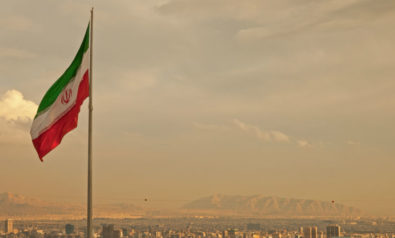Extreme ideologies, the “isms” that appear as bloodstained blots on the narrative of human history, take on many shapes and colors.
Background
In recent years, “extremism” has become a buzzword for global media, tied to the shadowy threat of terrorism and its rapidly changing faces. But the causes and expressions of extremism are much more diverse and complex, reaching far beyond the actions and ideologies of groups such as al-Qaeda and the Islamic State (IS).
The word “extremism” was coined in the mid-19th century and is rarely used outside of Western political dialogue.
Today, for instance, with all eyes on the conflicts in the Middle East, few think to make the comparison to Western culture’s own history of extreme religious violence. The use of child soldiers, one of the most controversial aspects of the Islamic State’s reign of terror, is comparable to the Children’s Crusade that saw thousands of children die and many more sold into slavery in a quest to drive Islam from the Holy Land.
Throughout history, narcissistic, power-hungry leaders have used religion to mask their political ambitions, resorting to dramatic means of manipulation. The Assassins, operating from their impregnable stronghold at Alamut castle, inflicted terror across the Middle East for almost two centuries, effectively pioneered suicide terrorism. The Zealots’ campaign of terror against the Romans in Judea culminated in a mass suicide of nearly 1,000 fighters besieged by the Romans at Masada fortress. Phan Xing Long’s uprising against the French in Vietnam came to a predictable conclusion when his acolytes, who believed they were made invisible by a magic potion, were rounded up by police.
The 20th century saw the coming to power of forces based on extreme secular ideologies, like Nazism in Germany, Stalinism in the Soviet Union or the Khmer Rouge in Cambodia. Based around a cult of personality of a tyrannical leader, these regimes were responsible for the deaths of tens of millions—both through state persecution and by the hands of those who blindly followed them. These persecutions were brutal and often arbitrary. So, Pol Pot carried out caricatures of Joseph Stalin’s purges, executing not only intellectuals, but anyone who wore glasses, claiming they were a sign of too much reading and not enough work.
We know it is possible, even easy, to descend into such inhumanity given the right circumstances. The Milgram Experiment—one of the best-known studies of human nature—is infamous for its results, which seem to support the rationalization so common to war criminals: “I was just following orders.”
Other studies have shown that the descent into monstrosity is not strictly the result of external factors. Equally well-known is the Stanford Prison Experiment, which separated test subjects into groups of guards and prisoners in a simulated prison environment. The experiment was halted less than halfway through its duration due to intense, unforeseen brutality on the part of the “guards.”
The reasons behind the attraction and success of extreme ideologies are complex and manifold. It would be easy to dismiss those who join terrorist organizations or religious cults as naïve or hopelessly misled. Yet aside from succumbing to propaganda and mind manipulation, real socioeconomic and political factors play a major role. Poverty and lack of education are well-known drivers of extremism, often enhanced by a sense of social injustice.
It is the “just” factor that introduces another dimension to our understanding of “extremism.” Take, for instance, the institution of slavery in the United States or South African apartheid. Both saw millions of black Africans dehumanized and forced into labor. And both had opponents—the African National Congress (ANC) and the Abolitionist movement—who were themselves considered terrorist groups until the change in the status quo.
Why is Extremism Relevant?
The dialogue concerning extremism is often so one-sided that it becomes difficult to see the situation without an imposed moral slant. This often results in responses to perceived extremism that are themselves extremist. The far-right backlash across Europe exemplified by the likes of PEGIDA, the English Defence League or the massacre perpetrated by the “lone wolf” Anders Breivik in Norway have shocked liberal societies as much as the perceived jihadist threat that fuel them.
Extreme ideologies, the “isms” that appear as bloodstained blots on the narrative of human history, take on many shapes and colors. From environmental activism and governmental disenfranchisement, to the various forms of religious and cult radicalism, inspirations range from idealism and social protest, to struggles for power and resources.
Yet all these movements have one thing in common: Swept up by their ideological missions, they often leave death and destruction in their wake. In trying to attain the goals that initially drew in members, they make mockeries of their own lofty causes.
As the norms and value systems of societies change, what was considered to be a fringe ideology often becomes the accepted norm, and vice versa. But what distinguishes “one man’s freedom fighter” from “another man’s terrorist” is the worship of an idea beyond any respect and consideration for human life.
By examining these movements and events within their own contexts, with the benefit of balanced viewpoints not influenced by the rabid rhetoric often connected with the word “extremism,” there is a need to better understand its origins and engage in more effective prevention.
The views expressed in this article are the author’s own and do not necessarily reflect Fair Observer’s editorial policy.
Photo Credit: Everett Historical / Alexskopje / Shutterstock.com
 We bring you perspectives from around the world. Help us to inform and educate. Your donation is tax-deductible. Join over 400 people to become a donor or you could choose to be a sponsor.
We bring you perspectives from around the world. Help us to inform and educate. Your donation is tax-deductible. Join over 400 people to become a donor or you could choose to be a sponsor.
For more than 10 years, Fair Observer has been free, fair and independent. No billionaire owns us, no advertisers control us. We are a reader-supported nonprofit. Unlike many other publications, we keep our content free for readers regardless of where they live or whether they can afford to pay. We have no paywalls and no ads.
In the post-truth era of fake news, echo chambers and filter bubbles, we publish a plurality of perspectives from around the world. Anyone can publish with us, but everyone goes through a rigorous editorial process. So, you get fact-checked, well-reasoned content instead of noise.
We publish 2,500+ voices from 90+ countries. We also conduct education and training programs on subjects ranging from digital media and journalism to writing and critical thinking. This doesn’t come cheap. Servers, editors, trainers and web developers cost money.
Please consider supporting us on a regular basis as a recurring donor or a sustaining member.
Support Fair Observer
We rely on your support for our independence, diversity and quality.
Will you support FO’s journalism?
We rely on your support for our independence, diversity and quality.



















